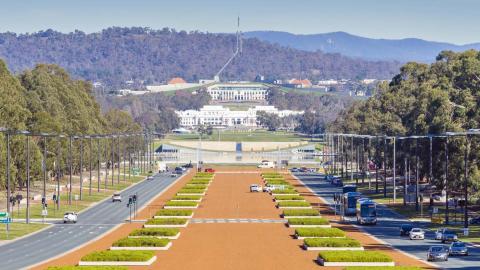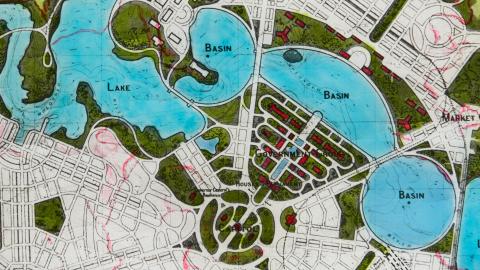
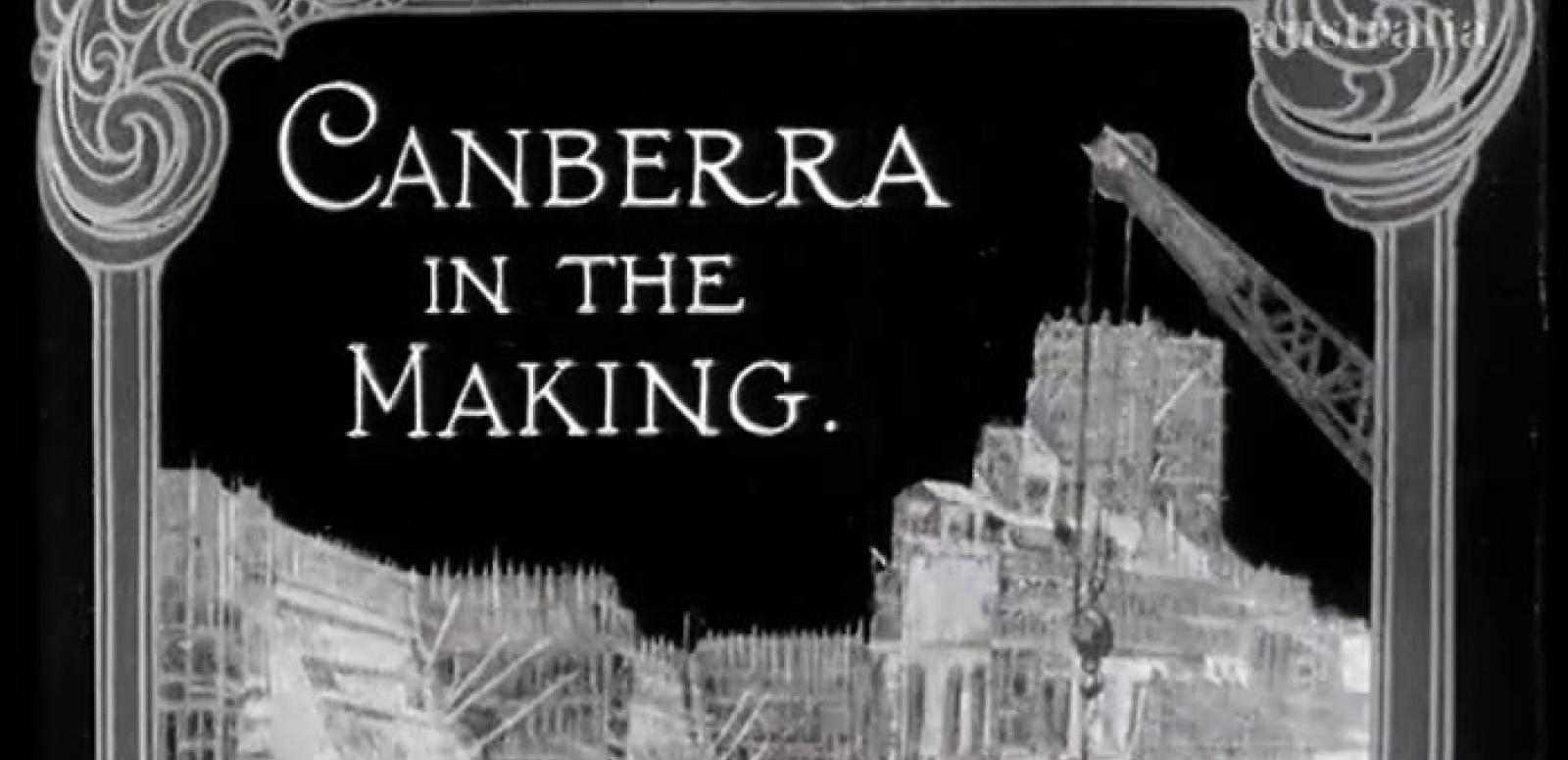
Canberra time capsule
Canberra time capsule
Canberra is the capital city of Australia located in the Australian Capital territory (ACT). It is Australia’s largest inland city with a population under 400,000 people.
There are many film and sound titles relating to Canberra in the NFSA collection. This sample of items, dating from the 1910s to 2010s, highlights the people of Canberra and some of the major events in the history of the city. It is a rare 100-year record of the birth and development of a national capital.
If you have any information about the people or places in these films, we would love to read your comments.
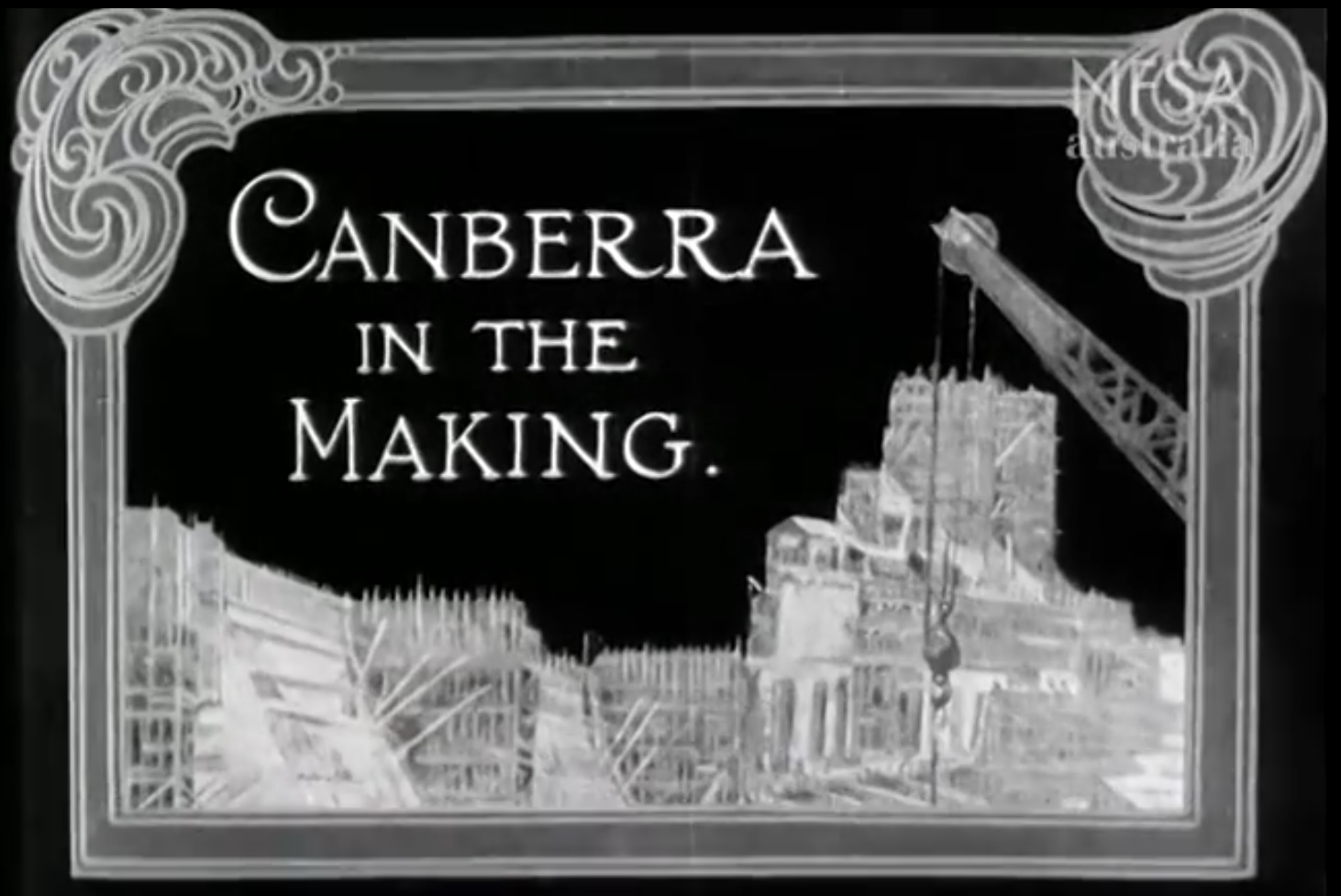
1910s
In 1908 the site of the nation’s capital was chosen as a compromise between rival cities, Sydney (NSW) and Melbourne (Vic). It was decided that Canberra was to be a wholly planned city. An international contest attracted 137 entries from 15 countries and in 1912 led to the selection of a design by Chicago (US) architects Walter Burley Griffin and Marion Mahony Griffin. The Griffins’ plan featured geometric motifs such as circles, hexagons and triangles, and was centred on axes aligned with significant topographical landmarks. The foundation stone was laid on 12 March 1913 and construction commenced soon after.
On the morning of Wednesday 12 March 1913, 500 invited guests, over 700 mounted and artillery troops and a public crowd of over 3000 locals came to witness the formal naming of Canberra. Foundation stones were laid by Governor-General Lord Thomas Denman, Prime Minister Andrew Fisher and the Minister for Home Affairs, King O’Malley. The national anthem was played and Lady Gertrude Denman announced the chosen name for the new-born federal capital. This recently completed digital restoration of the film, with music by Elaine Loebenstein, includes beautiful, clear images of guests arriving to watch the ceremony. Many of the troops seen in the film would soon be sent to fight overseas during the First World War. The film, directed by Raymond Longford and shot by Ernest Higgins, ends with a long panoramic sweep from Mt Pleasant taken the day after the ceremony.
Following the laying of the foundation stone, about 400 guests attended a banquet in a marquee that had been erected on Kurrajong Hill, now Capital Hill. Speeches were made by Prime Minister Fisher and Minister O’Malley. This recording of the Governor-General Lord Denman’s speech delivered at the banquet was possibly first recorded in the 1930s by a radio engineer in Melbourne, who also invited O’Malley and Lady Denman to recreate their speeches from the naming ceremony.
1920s
This compilation includes an empty paddock marked out for the future Parliament House as well as the building itself under construction and completed. The Melbourne and Sydney buildings in the civic centre stand largely alone as a city and suburbs gradually grow around them.
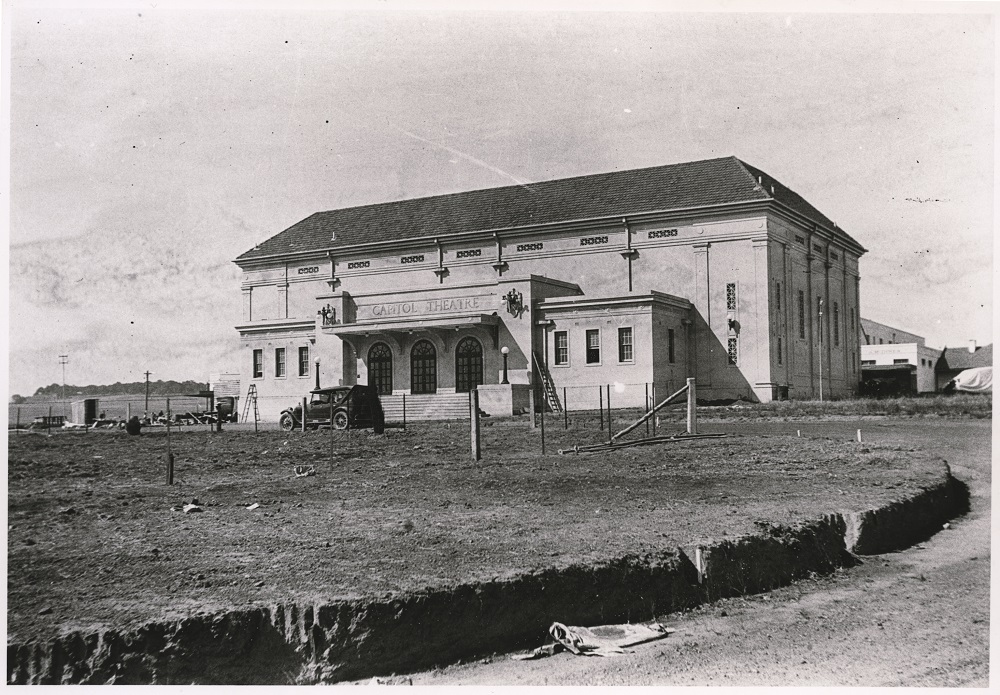
Federal Parliament House in Canberra was opened with much ceremony on 9 May 1927 by the Duke of York, later King George VI. Included in the proceedings was the singing of the national anthem, ‘God Save the King’, by Dame Nellie Melba. This official film of the event was originally silent but the NFSA commissioned a musical accompaniment, devised and performed by Elaine Loebenstein.
The Capitol Theatre was opened by the Governor-General, Baron Stonehaven, on 8 December 1927. The Capitol was an immense, white, rectangular structure. Its front entrance faced a dusty road, called Manuka Circle. It was later suggested that it faced the wrong direction. The first manager was film cameraman and director, Franklyn Barrett.
This home movie from 1929 shows Canberra residents playing in the snow in Civic, between the Sydney and Melbourne buildings. Snow in the city is rare these days but perhaps the most memorable fall occurred during a rugby league match between the Canberra Raiders and Wests Tigers in May 2000.
1930s
This ‘exclusive’ Cinesound Review newsreel opens with a view of Parliament House and a voice-over stating Australia has been experiencing a dramatic politic crisis. This refers to the sudden death of Prime Minister Joseph Lyons on 7 April 1939. On 18 April, the United Australia Party (UAP) elected Robert Menzies as its new leader and he was sworn in as prime minister eight days later.
Menzies addresses the Australian public in an informal and candid manner. He stands alone on the lawns of Parliament House, his right arm in a sling from a fall the previous day, speaking without notes and being surprisingly self-deprecating. He only mentions being the new leader of the UAP, not the new Australian prime minister. Given his unusual rise to the position and not being a prime minister directly elected by voters, he is perhaps deliberately choosing to play down his appointment and appear as an ‘everyman’. This is reinforced by the complete absence of any of the trappings of political office. It is filmed outside rather than inside Parliament House, there are no emblems of Australia – no flags or coat of arms – no reference to the Commonwealth of any kind which is in stark contrast to what we now know of Menzies and his devotion to the British monarchy. The voice-over also mentions Menzies’ appointment coming at a time of international tension. Menzies himself refers to Australia’s security as being not merely a problem for 70,000 young men but requiring everyone to join together in a spirit of self-sacrifice if Australia is to be safe. These comments presage the Second World War and, within months of this footage, Menzies delivered a famous radio broadcast informing the nation that Australia was at war.
1940s
An Australian Government film providing, ‘… a simple sketch of the capital and its people…’. In 1945 Canberra’s population was 12,000 and said to mostly know each other by sight. Included is footage of the Duke and Duchess of Gloucester. The Duke had been appointed Governor-General of Australia the year before, partly to ensure Britain’s continued defence of Australia during the Second World War.
1950s
A look at the seasons of Canberra, referred to in this 1952 government film as, ‘Australia’s Garden City’, in contrast to today’s more common title, ‘The Bush Capital’. Canberra’s extreme temperatures can fall as low as -10°C in winter and reach over 40°C in summer.
1960s
A purpose-built ornamental lake was part of Walter Burley Griffin’s original design for Canberra. The lake ‘served to unify and crystallise the entire concept of the national capital’. Before filling the lake, a working model was created to examine water flows, including what might happen during flood conditions. Bridges and dams were completed by September 1963 but a drought meant that the target water level was not reached until April 1964. It was formally inaugurated on 17 October 1964 by Sir Robert Menzies.
1970s
One of Canberra’s, and Australia’s, most dramatic events was the reading of the proclamation of the dismissal of the Whitlam Labor government on the steps of Parliament House on 11 November 1975. David Smith, official secretary to Governor-General Sir John Kerr, reads the proclamation. When we strip away the images and only listen to the audio we can appreciate Whitlam’s skill as an orator. He speaks slowly and clearly, waiting for the effect of each phrase on the crowd, saving his more powerful phrases for the end of each sentence. Among the noisy crowd is also heard an appeal for an Australian republic.
1980s
Colin Winchester was an Assistant Commissioner in the Australian Federal Police (AFP). He is also Australia’s most senior police officer to have been murdered. On 10 January 1989, at about 9:15 pm, he was shot twice in the head and killed while parking his police vehicle in the driveway of his home. After a four-year surveillance investigation, David Harold Eastman was convicted of Winchester’s murder on 11 November 1995.
This short news item makes the stunning announcement of the lifting of the suppression order of the name and particulars of the man suspected of killing Winchester. By the time of this broadcast the trial was in its fourth week. We hear a surprising amount of detailed information about the case in a very short period of time. Included is slow-motion footage of the accused, David Eastman, walking outside his Canberra townhouse; he is casually dressed, wearing thongs and tossing a set of keys. While the footage has probably been slowed down because of its brevity, it has the effect of looking like surveillance film and subtly suggests the accused is confident he has ‘gotten away with murder’. In fact, in 2014 Justice Brian Ross Martin found there had been ‘a substantial miscarriage of justice’ and that Eastman ‘did not receive a fair trial’. On 22 August 2014 the Supreme Court of the Australian Capital Territory quashed Eastman’s conviction and ordered a retrial.
1990s
The Royal Canberra Hospital closed on 27 November 1991 despite protests from Canberra residents, many of whom had been born there. In 1995, the site was earmarked for the future National Museum of Australia. The ACT Government decided to turn the demolition of the hospital buildings into a celebration and invited spectators to attend. Over 100,000 people, about one in three Canberrans and one of the largest crowds in Canberra’s history, gathered to witness the final stages of demolition. Instead of a celebration, the event had tragic consequences when the implosion failed and large items of debris were projected into the crowds on the opposite side of the lake. A 12-year-old girl, Katie Bender, was killed and nine other people injured.
This news item was part of a special broadcast presented the day after the explosion. The mood is sombre and the language, images and interviews appeal to Canberra as a single community that has shared the experience; as the news anchor says, ‘…what follows will be etched in the memories of us all for years to come’. The item makes good use of footage of the explosion, including home video footage, that clearly shows the danger that spectators were exposed to. The clips of AFP Assistant Commissioner, Bill Stoll, provide the official response but what is more emotive are the interviews with ordinary Canberrans talking about their experiences and illustrating the degree of danger and the impact on the city. Mitch McSweeney holds a six kilogram shard of twisted metal that flew one kilometre from the blast, sliced a tree and smashed a car windscreen. As he poignantly says, ‘I was born in Canberra Hospital. I was lucky not to be killed by it as well.’ The segment ends with a distressed and unidentified woman expressing her feelings, representing the distress felt by many Canberrans on that day.
2000s
Saturday 18 January 2003 was hot, windy and dry with a forecast of 40°C temperatures and winds exceeding 60 kilometres per hour. Lightning strikes a week earlier had started four fires in close proximity to Canberra. By 2 pm on 18 January, police had evacuated the township of Tharwa to Canberra’s south and fires reached urban areas by 3 pm. Conditions soon worsened and, within ten hours, four people had died, 490 were injured and 500 homes destroyed.
The familiar ‘magisterial’ ABC jingle that opens this news broadcast carries a certain comfort, suggesting that what we are about to hear will be authoritative and informative. Presenter Peta Collins provides the essential information about the location of the fire, the weather conditions and road closures. It’s at times like these that Australia’s national broadcaster is a valuable and reassuring community resource. However, Collins’ words, ‘Canberra residents are stepping up preparations for an approaching fire front’, proved to be a gross understatement. Similarly, the following announcement by the ACT’s Chief Fire Officer, Peter Lucas-Smith, that rural properties were most at risk and they are not going to combat the fire until conditions abated, proved to err too much on the side of caution. A decision he later, in hindsight, regretted. This 666 ABC Radio Canberra broadcast was at 2 pm on that fatal day. It contains no real suggestion of the tragedy that was to follow in only a matter of a few hours.
2010s
In 2013 events and festivities took place throughout the year to mark 100 years since the naming of Australia’s federal capital. The NFSA presented a special screening, ‘Imagining the Capital: Canberra on Film’, in the Senate Rose Gardens on Sunday 10 March 2013. This event celebrated the centenary of Canberra with footage from the NFSA collection matched to accompanying live music. Performers included Stiff Gins, No Hausfrau, Rachael Thoms, Fred Smith, Louise Page, Christine Wilson, Elaine Loebenstein, Little Pattie (Patricia Amphlett), Kyle Manning, Tahlia Makunde and the NFSA Band.
The National Film and Sound Archive of Australia acknowledges Australia’s Aboriginal and Torres Strait Islander peoples as the Traditional Custodians of the land on which we work and live and gives respect to their Elders both past and present.
